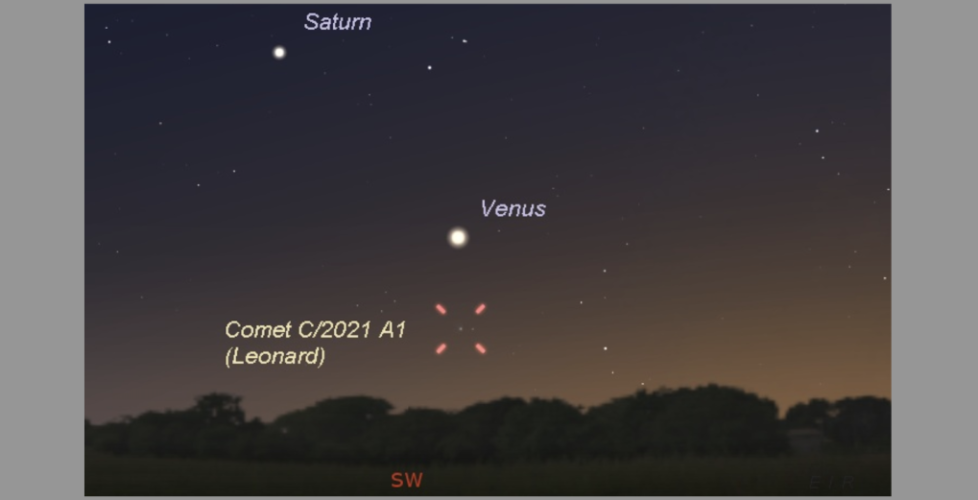Comet Leonard this Weekend, near Venus in Evening Sky
I’d like to alert you to a good opportunity to see the best comet of 2021 this weekend: Comet Leonard. Feel free to pass this information to your family and friends, if you wish.
A comet is a ” dirty iceball” (or an ” icy dirtball” — depending on the relative amounts of ice and dust) that comes from the deep freeze of the outer Solar System, beyond the orbit of Neptune. It heats up as it gets closer to the Sun, and the ices sublimate, becoming gas. This releases a cloud of dust that becomes visible by reflecting sunlight; the ” coma” of dust surrounds the nucleus, and the tail points roughly away from the Sun. The gas can also glow, and it points directly away from the Sun.
Comet Leonard, the brightest comet of 2021, has now conveniently moved from the morning sky to the evening sky, and will be very close to the brightest planet (Venus) the next few nights, making it easier to find. In clear, dark skies with a low southwest horizon, the comet’s nucleus might be visible to the unaided eye as a faint and fuzzy ”star.” You are much more likely to see it through binoculars; this will reveal the coma and perhaps also the tail. Photographs obtained with a digital camera mounted on a tripod will reveal more of the coma and tail (typical exposure time 4-20 seconds). You can find many excellent photos of the comet online (e.g., https://earthsky.org/astronomy-essentials/comet-leonard-might-become-2021s-brightest-2022/). After passing closest to the Sun on January 3, 2022, the comet will be ejected from our Solar System.
To find Comet Leonard, look to the southwest shortly after sunset in a darkening sky — around 5:20-5:30 pm (local time) would probably be best. It will be a little below Venus (the brightest object in the southwest sky) on the evening of Friday, December 17; see the attached chart (made by Eddie Irizarry using Stellarium software). On Saturday, December 18, it will be a little below and to the left of Venus, and on Sunday, Dec. 19, it will be farther to the left of Venus (and still a little below). Slowly scan that part of the sky while looking through binoculars. You’ll need to have a clear, low southwest horizon, not blocked by trees, hills, buildings, or other obstructions. Beyond Dec. 19, the comet could still be visible (progressively farther to the left of Venus), but it is expected to fade.
Good luck, clear skies, and happy holidays,
Alex

